A Short History of the Hemingray Glass Co. - Part 2 of 4
by H. G. "BEA" HYVE
Reprinted from "INSULATORS - Crown Jewels of the Wire", January 1982, page 7
The last listing of any connection to Hammond St. was in 1856. In 1857 and 1858, 14 Main
St. was listed. From 1859 through 1867, a warehouse is listed at 20 E. 2nd. So
Gray & Hemingray was completely moved out of Hammond St. probably by late
1855 or very early in 1856.
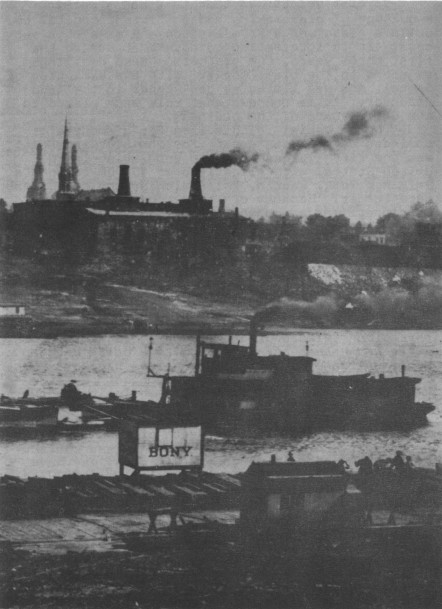
Large Image (156 Kb)
Although the company probably moved into already
existing buildings, the structures on the site today are of a type of
construction which suggests they were undoubtedly built sometime after 1853.
In fact, a clipping from the Daily Commonwealth of Covington dated 1 Feb. 1881
may refer to the building presently on the site. It says, "The new
Hemingray Glass Works building on Second street completed, and the store of the
firm, heretofore on Walnut street, in Cincinnati, will be removed to the new and
commodious building adjoining the factory in this city." It is probably
safe to assume that the basic structure of the existing building is the 1881
building. But no doubt a lot of modifications have been made over the years.
The
offices as well as the glass-manufacturing plant were located at 2nd and Madison
in Covington, an the northwest corner. The accompanying photo shows the factory
in operation at this location, and was taken from the Cincinnati side looking
toward Covington. Note the barge in the foreground. The photo was taken sometime
in the 1870's, and the words "R. Hemingray" are visible at the top of
the building.
In 1857 Anthony Gray (Ralph's brother) and Samuel J. Hemingray
(Robert's brother) became partners, causing the company's first name change. It
was now called Gray, Hemingray & Bros. Four years later, in 1861, it was
changed for the second time to Gray, Hemingray & Bro., for about this time
Anthony Gray was no longer active in the business. This name lasted until 1864
when Ralph Gray died. At this time Robert and Samuel Hemingray changed the name
for a third time to Hemingray Bros. & Co. The "Co." included
Richard Evans and James Foley. Anthony Gray died in 1865.
In September of 1866
Samuel Hemingray died. In the Covington directory for 1868-69 we discover the
fourth name change, which apparently lasted for about two years R. Hemingray
& Co. Also listed in that year's directory is a company warehouse at 68
Walnut St., Cincinnati.
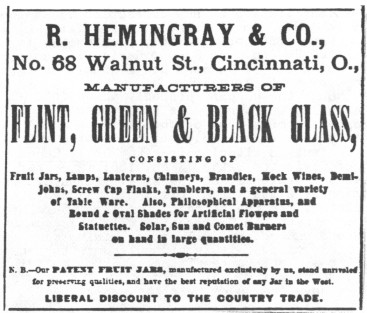
Williams' Cincinnati Directory and Business Advertiser
1867
(Courtesy of Glenn Drummond)
The year 1869 also saw the beginning of the production
of threaded insulators by the company -- the unembossed CD 127 and CD 131.4. The
following year, 1870, the name was changed for the fifth and last time to the
Hemingray Glass Co., at which time also the company was incorporated. The
Hemingray Glass Co. would exist for another 63 years, on into the first one
third of the following century.
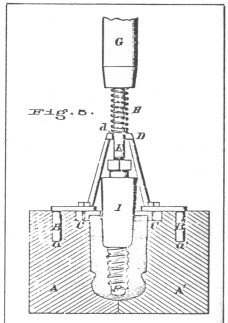
Portion of 1871 patent
by Robert Hemingray
(Courtesy of Mike Sovereign)
On December 19, 1871, Robert Hemingray was
issued a patent for "a new and useful process in molding telegraph
insulators". In Patent No. 122,015 Hemingray says, "I claim herein as
new and of my invention...the mode or process of forming the unthreaded wider
portion of the cavity by a threadless plunger, and, while the glass is yet hot,
forming the threaded deeper portion by means of a screw-threaded plunger or
mandrel...".
(The illustration on the previous page is an axial section
showing the plunger in position within the mold).
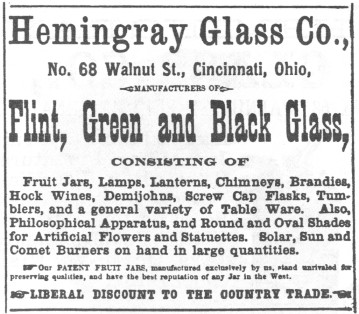
Williams' Cincinnati Directory and Business Advertiser
1871
(Courtesy of Glenn Drummond)
Although there would be no
more name changes, the company had one more move coming up. Being as close to
the river as they were had its good points but it also had its drawbacks. Such
easy access to the water made the loading and unloading of products and supplies
fairly convenient, but this convenience was outweighed by the reality that
rivers sometimes flood. And this is exactly what happened two years in a row. In
both 1883 and 1884 the Ohio River at Covington rose over 14 feet above flood
stage, which was more than 6 feet above the company's foundations. The damage to
the Hemingray facility caused by those floods prompted company officials to look
for "higher ground". And they found it approximately 100 miles to the
northwest, in Muncie, Indiana.
THE MUNCIE YEARS
About this same time, the Muncie
area was endeavoring to lure new business with offers of cheap and abundant
natural gas, newly discovered in the region. So in 1888 the Hemingray Glass Co.,
in an effort to find cheaper fuel as well as dryer ground, purchased a site in
Muncie on Macedonia Ave. Construction of the new plant began immediately, with
work being completed by 1890.
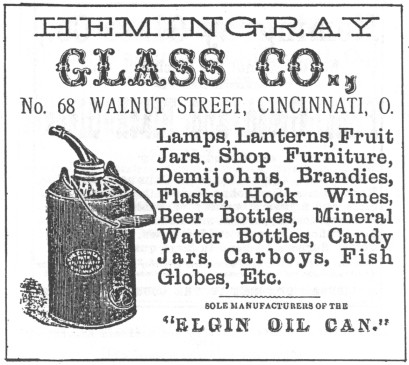
Covington City Directory, 1878
(Courtesy of Franklin Jaquish)
In 1892 Robert Hemingray retired from active
participation in the company, although retaining his title of president. His
oldest son, Ralph, who was company vice-president, assumed executive charge.
Those who knew both father and son say that Ralph looked very much like his
father. John Macken of Muncie, who knew Ralph Hemingray, describes him as a
"short fellow, who rolled his own cigarettes". (Mr. Macken started
working for the Hemingray Glass Co. in 1918 and retired from Owens-Illinois in
1965).
In the summer of this same year of 1892, just when the factory had become
well established, the plant was partially destroyed by fire, causing temporary
interruption in production. Covington was revitalized and took over production
in the interim. Muncie was promptly rebuilt, however, and resumed operation in
better condition than before and with a minimum of delay.
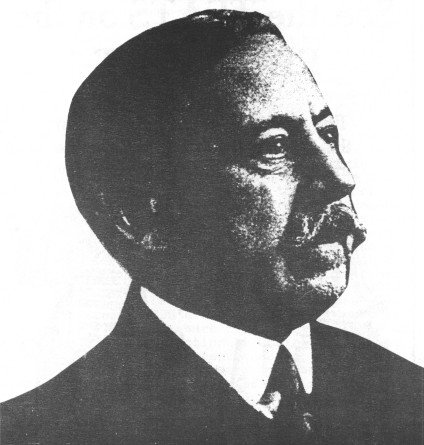
Ralph Gray Hemingray
1852-1920
(c. 1900)
(Courtesy of Ruth Crawford and the Muncie Public Library)
| 